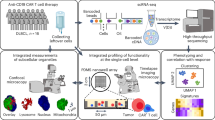Abstract
Marginal zone B cell lymphoma (MZBCL) represents a distinct subtype of B cell non-Hodgkin’s lymphoma, which has been recently recognized and defined as a disease entity. We investigated 25 cases (18 at primary diagnosis and seven during the course of disease) of MZBCL by comparative genomic hybridization (CGH) and compared these results with cytogenetic, fluorescence in situ hybridization (FISH), and Southern blot data. Twenty of the 25 cases (80%) showed gains (total 49) or losses (total 15) of genetic material. In extranodal, nodal, and splenic MZBCL, material of chromosomes 3 (52% of cases), 18 (32%), X (24%), and 1q (16%) was most frequently gained, whereas losses predominantly involved chromosomes 17 (16%) and 9 (12%). High-level amplifications involving the regions 18q21-23 and 18q21-22, respectively, were detected in two cases. Gains of chromosomes 1q and 8q and losses of chromosome 17 or 17p occurred more frequently in relapsed or progressive lymphomas. For all of the frequently affected chromosomes, CGH allowed narrowing of the relevant subregions including 3q21-23, 3q25-29 and 18q21-23. By Southern blot analysis, the BCL2, BCL6, and CMYC proto-oncogenes were found to be a part of the over-represented regions in two cases, one case, and two cases, respectively, with gains involving 18q, 3q or 8q. In 13 cases, CGH revealed chromosomal imbalances which were not detected by cytogenetic analysis but could be confirmed by FISH or Southern blot analysis in all cases investigated. On the other hand, CGH failed to detect trisomy 3, trisomy 18, and deletion 7q in three cases with a low proportion of tumor cells bearing these abnormalities, as shown by interphase FISH. The characteristic pattern of chromosomal gains and losses detected in this study confirms the distinct nature of MZBCL and may point to chromosomal regions involved in the pathogenesis of these neoplasms.
This is a preview of subscription content, access via your institution
Access options
Subscribe to this journal
Receive 12 print issues and online access
$259.00 per year
only $21.58 per issue
Buy this article
- Purchase on Springer Link
- Instant access to full article PDF
Prices may be subject to local taxes which are calculated during checkout
Similar content being viewed by others
Author information
Authors and Affiliations
Rights and permissions
About this article
Cite this article
Dierlamm, J., Rosenberg, C., Stul, M. et al. Characteristic pattern of chromosomal gains and losses in marginal zone B cell lymphoma detected by comparative genomic hybridization. Leukemia 11, 747–758 (1997). https://doi.org/10.1038/sj.leu.2400635
Received:
Accepted:
Issue Date:
DOI: https://doi.org/10.1038/sj.leu.2400635
Keywords
This article is cited by
-
Genomic landscape of Epstein–Barr virus-positive extranodal marginal zone lymphomas of mucosa-associated lymphoid tissue
Modern Pathology (2022)
-
Proliferation centers in chronic lymphocytic leukemia: correlation with cytogenetic and clinicobiological features in consecutive patients analyzed on tissue microarrays
Leukemia (2012)
-
Oncogenically active MYD88 mutations in human lymphoma
Nature (2011)
-
Comparative expressed sequence hybridization studies of t(11;18)(q21;q21)-positive and -negative gastric MALT lymphomas reveal both unique and overlapping gene programs
Modern Pathology (2010)
-
The prevalence of IG translocations and 7q32 deletions in splenic marginal zone lymphoma
Leukemia (2008)



